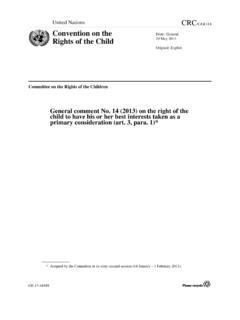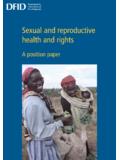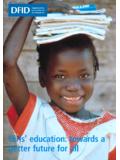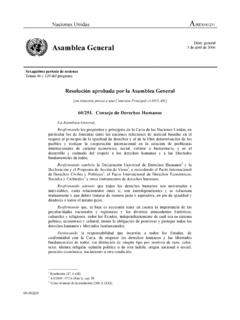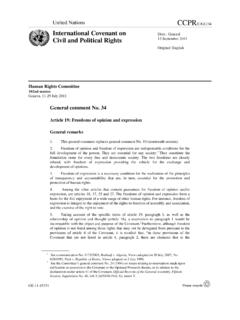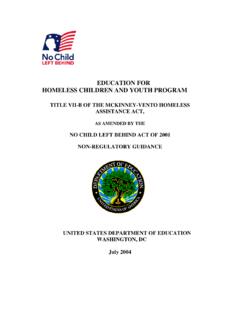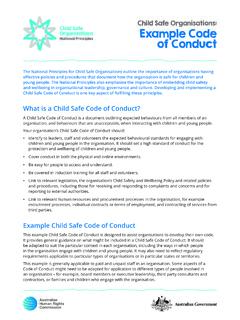Transcription of UNITED CRC NATIONS
1 UNITED NATIONS CRC Convention on the rights of the child Distr. GENERAL CRC/C/GC/12 1 July 2009 Original: ENGLISH ADVANCE UNEDITED VERSION COMMITTEE ON THE rights OF THE child Fifty-first session Geneva, 25 May-12 June 2009 GENERAL COMMENT No. 12 (2009) The right of the child to be heard CRC/C/GC/12 page 2 CONTENTS Paragraphs Page I. II. III. THE RIGHT TO BE HEARD: A RIGHT OF THE INDIVIDUAL child AND A RIGHT OF GROUPS OF A. Legal B. The right to be heard and the links with other provisions of the C. The implementation of the right to be heard in different settings and D. Basic requirements for the implementation of the right of the child to be E.
2 CRC/C/GC/12 page 3 The right of the child to be heard Article 12 of the Convention on the rights of the child provides: 1. States Parties shall assure to the child who is capable of forming his or her own views the right to express those views freely in all matters affecting the child , the views of the child being given due weight in accordance with the age and maturity of the child . 2. For this purpose the child shall in particular be provided the opportunity to be heard in any judicial and administrative proceedings affecting the child , either directly, or through a representative or an appropriate body, in a manner consistent with the procedural rules of national law.
3 I. INTRODUCTION 1. Article 12 of the Convention on the rights of the child (the Convention) is a unique provision in a human rights treaty; it addresses the legal and social status of children, who, on the one hand lack the full autonomy of adults but, on the other, are subjects of rights . Paragraph 1 assures, to every child capable of forming his or her own views, the right to express those views freely in all matters affecting the child , the views of the child being given due weight in accordance with age and maturity. Paragraph 2 states, in particular, that the child shall be afforded the right to be heard in any judicial or administrative proceedings affecting him or her.
4 2. The right of all children to be heard and taken seriously constitutes one of the fundamental values of the Convention. The Committee on the rights of the child (the Committee) has identified article 12 as one of the four general principles of the Convention, the others being the right to non-discrimination, the right to life and development, and the primary consideration of the child s best interests, which highlights the fact that this article establishes not only a right in itself, but should also be considered in the interpretation and implementation of all other rights . 3. Since the adoption of the Convention in 1989, considerable progress has been achieved at the local, national, regional and global levels in the development of legislation, policies and methodologies to promote the implementation of article 12.
5 A widespread practice has emerged in recent years, which has been broadly conceptualized as participation , although this term itself does not appear in the text of article 12. This term has evolved and is now widely used to describe ongoing processes, which include information-sharing and dialogue between children and adults based on mutual respect, and in which children can learn how their views and those of adults are taken into account and shape the outcome of such processes. 4. States parties reaffirmed their commitment to the realization of article 12 at the twenty-seventh special session of the General Assembly on children in However, the Committee notes that, in most societies around the world, implementation of the child s right to express her or his view on the wide range of issues that affect her or him, 1 Resolution S-27/2 A world fit for children ,adopted by the General Assembly in 2002.
6 CRC/C/GC/12 page 4 and to have those views duly taken into account, continues to be impeded by many long-standing practices and attitudes, as well as political and economic barriers. While difficulties are experienced by many children, the Committee particularly recognizes that certain groups of children, including younger boys and girls, as well as children belonging to marginalized and disadvantaged groups, face particular barriers in the realization of this right. The Committee also remains concerned about the quality of many of the practices that do exist. There is a need for a better understanding of what article 12 entails and how to fully implement it for every child .
7 5. In 2006, the Committee held a day of general discussion on the right of the child to be heard in order to explore the meaning and significance of article 12, its linkages to other articles, and the gaps, good practices and priority issues that need to be addressed in order to further the enjoyment of this The present general comment arises from the exchange of information which took place on that day, including with children, the accumulated experience of the Committee in reviewing States parties reports, and the very significant expertise and experience of translating the right embodied in article 12 into practice by governments, non-governmental organizations (NGOs), community organizations, development agencies, and children themselves.
8 6. The present general comment will first present a legal analysis of the two paragraphs of article 12 and will then explain the requirements to fully realize this right, including in judicial and administrative proceedings in particular (sect. A). In section B, the connection of article 12 with the three other general principles of the Convention, as well as its relation to other articles, will be discussed. The requirements and the impact of the child s right to be heard in different situations and settings are outlined in section C. Section D sets out the basic requirements for the implementation of this right, and the conclusions are presented in section E. 7. The Committee recommends that States parties widely disseminate the present general comment within government and administrative structures as well as to children and civil society.
9 This will necessitate translating it into the relevant languages, making child -friendly versions available, holding workshops and seminars to discuss its implications and how best to implement it, and incorporating it into the training of all professionals working for and with children. II. OBJECTIVES 8. The overall objective of the general comment is to support States parties in the effective implementation of article 12. In so doing it seeks to: Strengthen understanding of the meaning of article 12 and its implications for governments, stakeholders, NGOs and society at large; Elaborate the scope of legislation, policy and practice necessary to achieve full implementation of article 12; Highlight the positive approaches in implementing article 12, benefitting from the 2 See the recommendations of the day of general discussion in 2006 on the right of the child to be heard, available at: CRC/C/GC/12 page 5 monitoring experience of the Committee.
10 Propose basic requirements for appropriate ways to give due weight to children s views in all matters that affect them. III. THE RIGHT TO BE HEARD: A RIGHT OF THE INDIVIDUAL child AND A RIGHT OF GROUPS OF CHILDREN 9. The general comment is structured according to the distinction made by the Committee between the right to be heard of an individual child and the right to be heard as applied to a group of children ( a class of schoolchildren, the children in a neighbourhood, the children of a country, children with disabilities, or girls). This is a relevant distinction because the Convention stipulates that States parties must assure the right of the child to be heard according to the age and maturity of the child (see the following legal analysis of paragraphs 1 and 2 of article 12).
